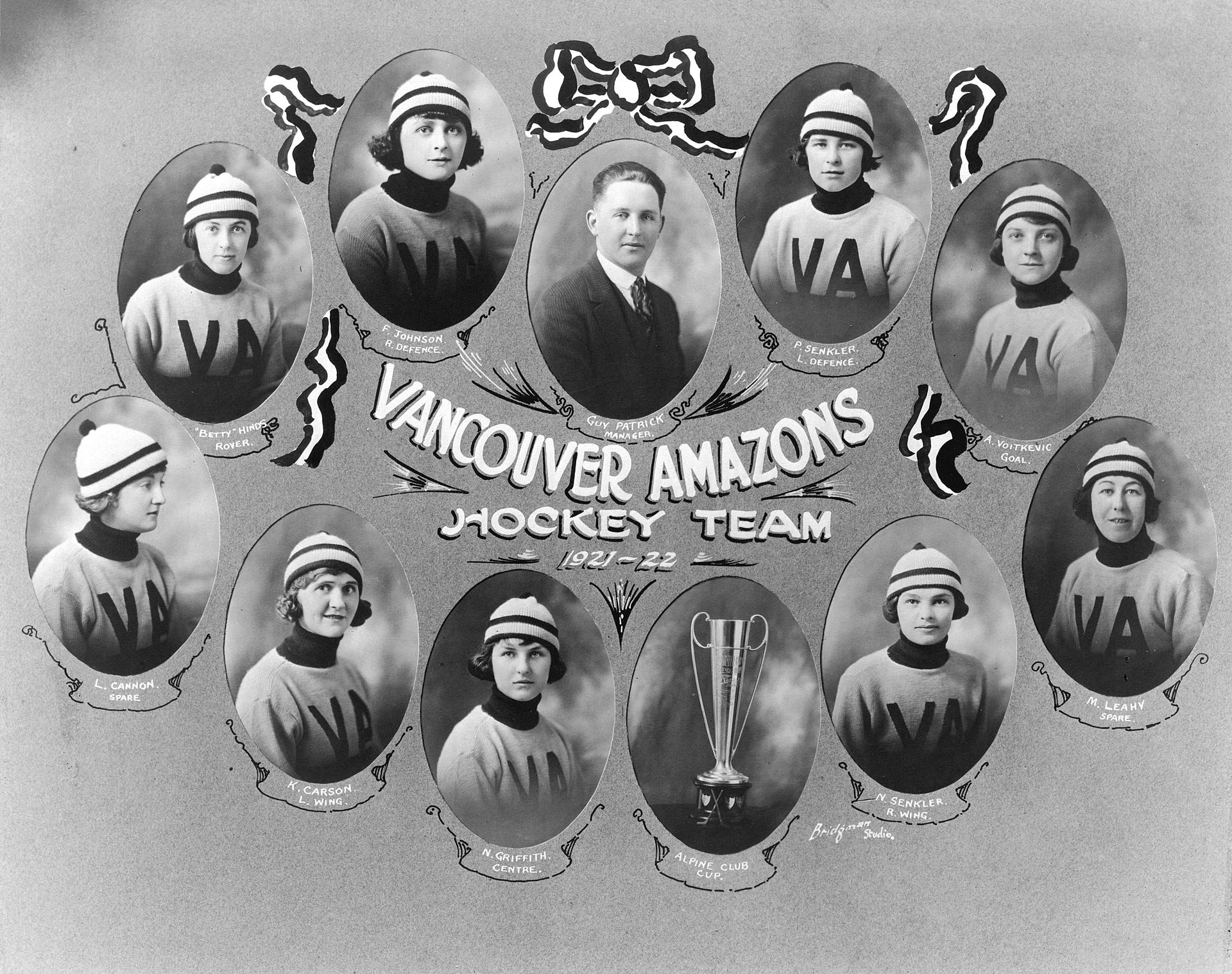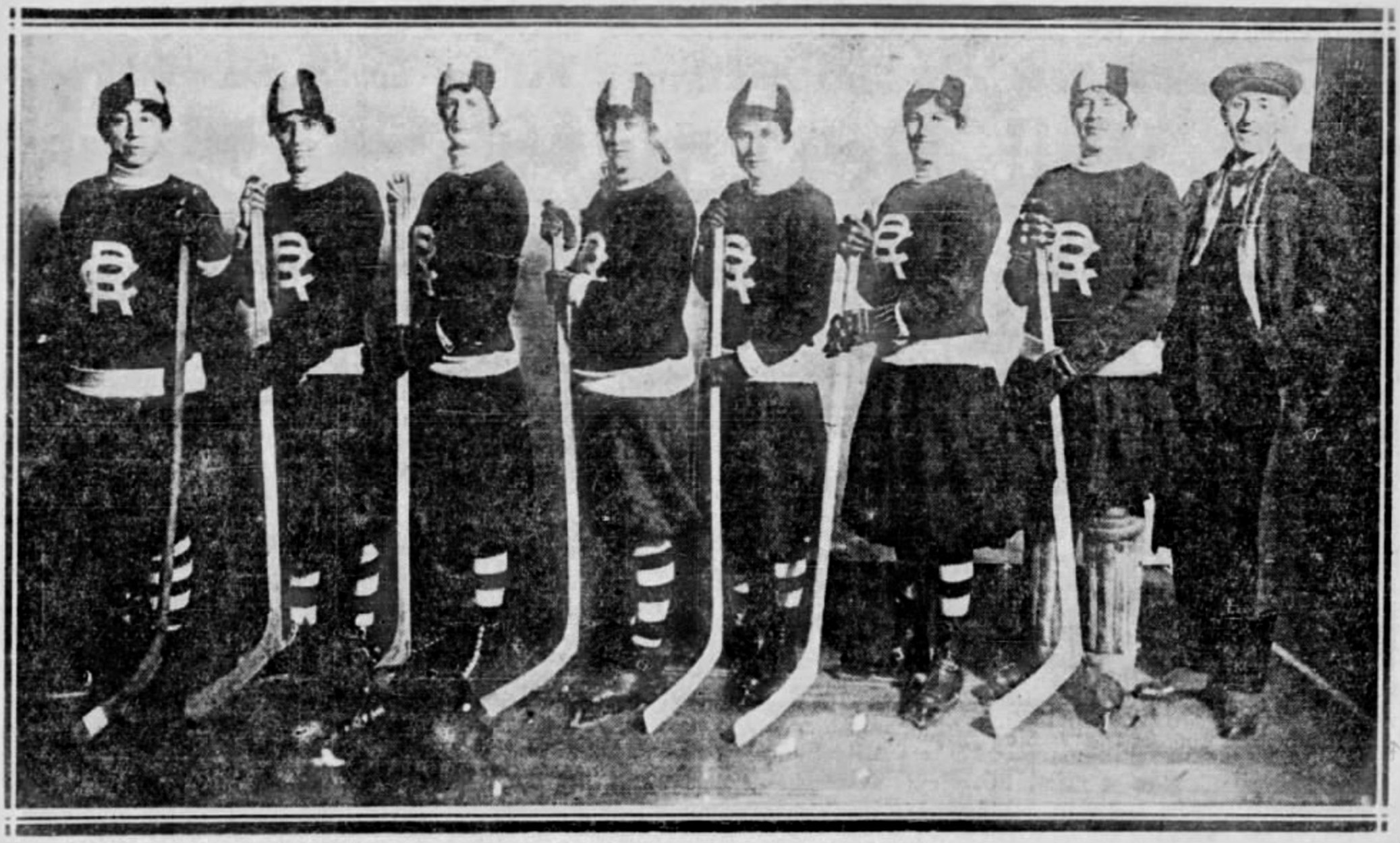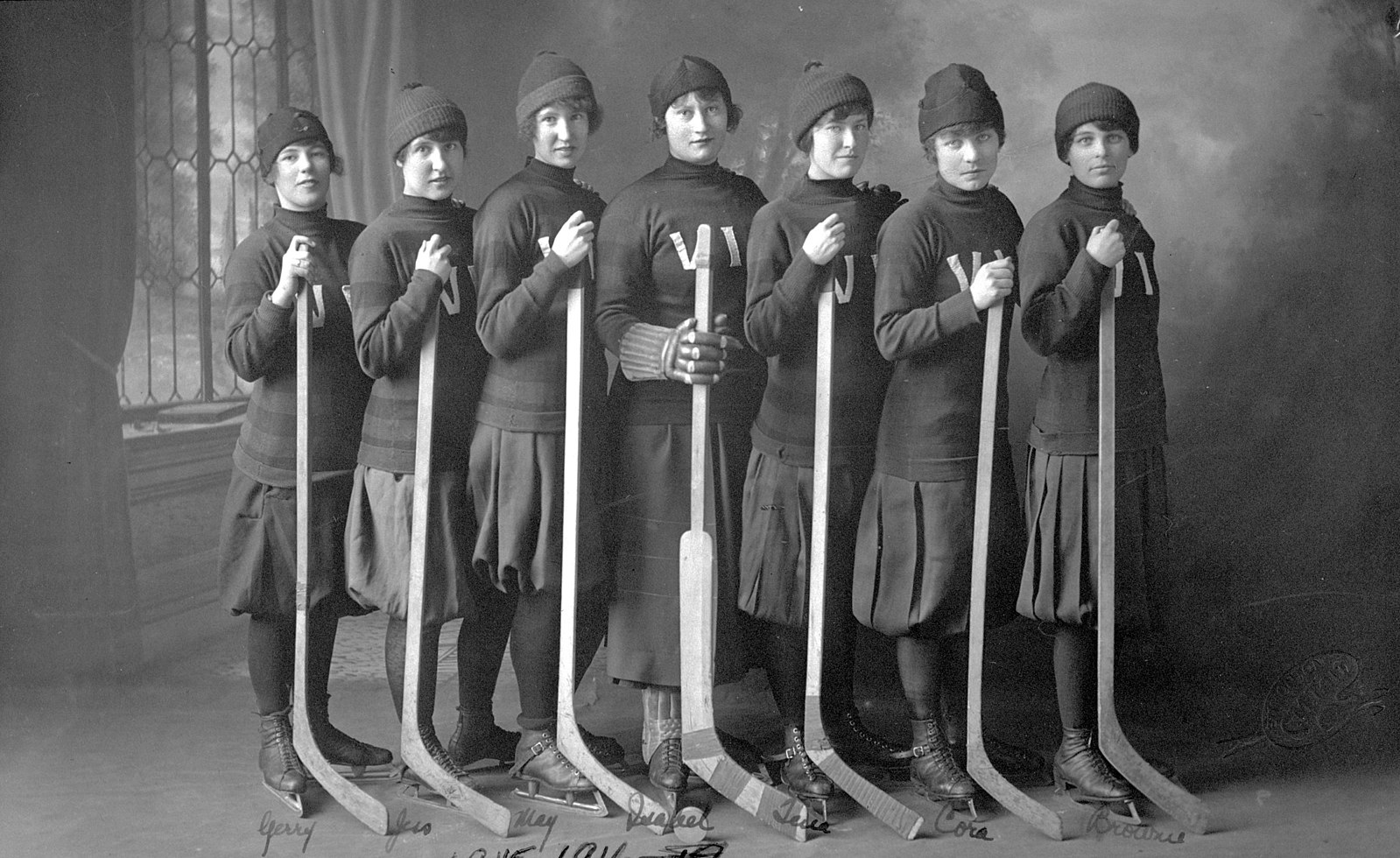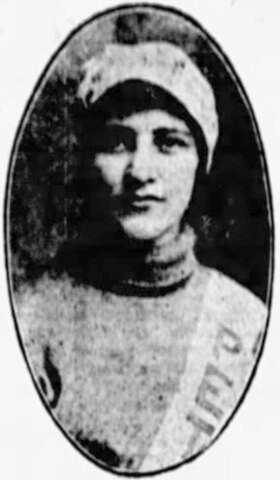sr edler
gold is not reality
- Mar 20, 2010
- 11,915
- 6,346
Women’s ice hockey had already been around for some time, in one form or another, during the earlier years of the sport’s organized infancy. But during the World War I window in the late 1910s, women’s hockey came to experience an increased boost in popularity.
This popularity boost was partly due to the fact that a large portion of the male players, both amateurs and professionals, had departed overseas for military service, and so the promoters of the sport had to look to other participants to sell out their arenas. But it was also partly due to one particular player, dubbed the ”Miracle Maid” by the English speaking press: one Miss Albertine Lapensée, a Franco-Ontarian puck chaser from Cornwall, the hometown of the famous Édouard “Newsy” Lalonde and the Denneny hockey family.
Miss Lapensée, born in August 1898 to Philippe and Mathilda Lapensée, was still in her late teens when she appeared on the bigger hockey scene, playing with the Cornwall Victorias and Cornwall Nationals in exhibition games against teams from Ottawa and Montreal. But despite her young age she displayed a strength and a bite to her game, which gave her a nice advantage over over her opponents, and also made some people question her identity.

Albertine Lapensée
In a January 29, 1916 game in Cornwall between the local Cornwall Victorias and the visiting Ottawa Alerts, Lapensée gave the crowd good value back on their spent money, not only by scoring the two decisive goals in a 3-1 victory, but also by wowing the crowd with some neat physicality reminiscent of another famous puck chaser. Ottawa Citizen, reporting on the game, described how Lapensée “gave the crowd a thrill when she bodychecked a la Art Ross.”[1]
On the Ottawa Alerts team starred Edith Anderson, Eva Ault, Helen Brown and Belle Rogers, with Anderson scoring the lone tally for the Ottawa side, but goals from Ada McDonald and Albertine Lapensée sealed the winning deal for the Cornwall ladies.
Albertine Lapensée made such an impressive showing on the ice during the onset of the 1915–16 season, that rumours soon began to appear that she was actually a boy, but these rumours were strongly rejected by the Cornwall camp. A reporter from the Montreal Daily Star made an inquiry into the accusation in early February of 1916, and his findings from Cornwall made him “thoroughly convinced” that she was indeed a girl, and that her impressive strength and proficiency in hockey had been acquired through practicing and playing with boys from an early age.[2]
The Cornwall women’s teams were managed by Mr. Garnet McDonald, a former player on the Cornwall men’s team in the Federal Amateur Hockey League (FAHL), and by Mr. Ernest Runions, an older brother of former FAHL player Zina Runions. And outside of Lapensée and Ada McDonald on the forward line, Cornwall also had Blanche Young in goal, Gertie Relyea and Maud Leitch on defense, forwards Jean Hodge and Betty Theobald, and substitute player Janet McCracken.

Cornwall Victorias in 1915–16 without Albertine Lapensée in the photograph
Back row: Jean Hodge, Gertie Relyea, Garnet McDonald, Ada McDonald, Janet McCracken
Front row: Maud Leitch, Blanche Young, Betty Theobald
The main promoter of women’s hockey in Montreal at the time was a gentleman named Len Porteous, who was the man behind the Montreal Westerns aggregation and the 1915–16 Eastern Ladies’ Hockey League (ELHL) in Montreal, where the Westerns played against the Maisonneuve Stanleys, North End Stanleys and Montreal Telegraphs.
While the Montreal Westerns, led offensively by their quick star forward Agnès Vautier, made an impressive showing over the season in the ELHL with 11 games won and one tied contest over a 12-game schedule, the Cornwall ladies turned out a decidedly harder nut to crack for the Westerns than the local Montreal teams.
Cornwall Victorias won the first of two home games against the Montreal Westerns on January 22 by a 1-0 score in front of 1,500 spectators, without Albertine Lapensée in the line-up. Victorias right winger Jean Hodge scored the game winning goal in the second period, beating Montreal’s net guardian Corinne Hardman for the tally.[3]
For the February 5 return contest between the two teams in Cornwall, Miss Lapensée was present in the line-up, and the local crowd had grown to an estimated figure between 2,500 and 3,000 people. With Lapensée in the game the goal count also grew exponentially, and when the puck bombardment finally was over the Cornwall ladies had walked away with an 8-0 victory, with four of the goals credited to Miss Lapensée and the rest of the goals credited evenly to Ada McDonald and Jean Hodge.[4]
After the February 5 game, Montreal Westerns manager Len Porteous vowed to play his goaltender Corinne Hardman in a baseball catcher’s mask for the third game between the two teams on February 12 at the Jubilee Rink in Montreal, to protect her face from the flying pucks fired by Miss Lapensée.
2,500 spectators were present at the Jubilee Rink in Montreal for the February 12 game, but the Montreal Westerns failed for a third time to defeat the Cornwall Victorias, with Lapensée scoring two impressive goals in the second period for a 2-0 victory.[5]

Montreal Westerns in 1915–16
Albertine Lapensée wasn’t only credited with a strong shot and physical upside, but also for displaying a strong overall game. After she had helped the Cornwall Victorias defeat the Ottawa Westboro Pets 5 goals to 2 on March 4, 1916 at Dey’s Arena in Ottawa, the Ottawa Journal gushed over her game:
So popular had women’s hockey become at the end of the 1915–16 season, a trip to Cleveland was organized by Ernest Runions and Ottawa’s Ernie Butterworth in liaison with Cleveland promoter Harry Shannon, for a joint Cornwall–Ottawa party to play a three-game series against each other at the Elysium Arena between March 15 and 18.
Albertine Lapensée, being just 17 years of age, was accompanied on the trip south of the border by her older sister Laurette, who appeared as a goaltender for the Cornwall team in the series. The Cornwall team won three straight games over the Ottawa team, and Lapensée contributed with 13 of her team’s 18 goals, the last game being played in front of a packed Elysium Arena.[7]
Cornwall Victorias remained undefeated over the course of the 1915–16 season, and Albertine Lapensée would continue with her good form into the 1916–17 campaign. In fact, she only seemed to get better.
After a game on January 19, 1917 between Cornwall and the Ottawa Alerts, where Lapensée’s 5 goals singlehandedly helped her team to a 6-3 victory, the Ottawa Journal claimed she was much improved from the 1915–16 campaign and “has had all the rough edges smoothed off in her skating and stickhandling.”[8]

Albertine Lapensée
While Lapensée’s continued form continued to wow the hockey audiences in Cornwall, Montreal and Ottawa, as well as in Quebec City, it simultaneously began to irk the managers of the rivaling teams, who grew more and more desperate in their attempts to find talent who could match up against the outstanding Miracle Maid.
One such talent scouted was an Indigenous girl named Alida Gros-Louis, or Atsebatabon, from L’Ancienne-Lorette in Quebec, who was said to stand at 5 feet and 9 inches. But even though Gros-Louis made a fine debut showing at cover point with the Montreal Socials against the Montreal Westerns on March 5, where she tallied her side’s lone goal in a 1-4 defeat, a rivalry with Lapensée never materialized from the acquisition.[9]
Another attempt at stacking up the ranks ended in embarrassment for Len Porteous, manager of the Montreal Westerns, when he thought he had found a gem in Miss Ada Lalonde from Woodlands, Ontario.
Ada Lalonde was said to be 17 years of age and a “wonderful skater”, and was out practicing with the Montreal Westerns on March 19, anxiously wanting to play Albertine Lapensée’s team.[10] But during another practice just two days later on March 21 “Miss Lalonde” spilled the beans that he was actually a boy, cleverly disguised as a girl. What was said to have caused the first suspicion that “Miss” Lalonde was really a “Mr.” was the fact that he unsuccessfully had tried to hide a cigarette in the photo that appeared of him in the March 20 issue of the Montreal Daily Star.[11]

“Miss Ada Lalonde”
Photo from Montreal Daily Star, March 20, 1917
Cornwall Victorias remained undefeated with Lapensée in the line-up also over the 1916–17 season, and the only defeat handed to the Factory Town girls came when the team split up in two and played two games concurrently on February 24, 1917. In Cornwall the home team lost 0-3 to the Ottawa Westboro Pets whereas a Lapensée led Cornwall aggregation, including fellow key players Eveline Bourgeon and Evelyn Lafave, defeated the Montreal Westerns 7 goals to 1 in Quebec, where Lapensée was responsible for each Cornwall tally.
Albertine Lapensée put up a goal scoring rate over the course of the 1916–17 season mimicking the numbers put up a decade earlier in men’s hockey by the great Russell Bowie, but sometime after the season had come to an end she abruptly departed for New York, reportedly swayed by the wonderful stories told to her about the big city south of the Canadian border.[12]
And so the Miracle Maid vanished from the hockey scene, after only two seasons in its spotlight.
Female puck chasers continued to have a place on the general hockey map even in the following years, both in the East with teams such as the Ottawa Alerts and Montreal Westerns, and in the West where teams from Calgary, Edmonton and Vancouver would compete for the Alpine Cup at the Banff Winter Carnival in Alberta’s Rocky Mountains.
But with the men back from World War I, and with the biggest and brightest drawing card gone in Miss Albertine Lapensée, the most ardent craze for women’s hockey seemed to cool off quite a bit.
Sources:
[1] Ottawa Citizen, Jan. 31, 1916
[2] Montreal Daily Star, Feb. 12, 1916
[3] Montreal Daily Star, Jan. 24, 1916
[4] Montreal Daily Star, Feb. 7, 1916
[5] Montreal Daily Star, Feb. 14, 1916
[6] Ottawa Journal, Mar. 6, 1916
[7] Montreal Daily Star, Mar. 20, 1916
[8] Ottawa Journal, Jan. 20, 1917
[9] Montreal Daily Star, Mar. 6, 1917
[10] Montreal Daily Star, Mar. 20, 1917
[11] Montreal Daily Star, Mar. 22, 1917
[12] Montreal Daily Star, June 23, 1917
Posted on Behind the Boards (SIHR Blog)
This popularity boost was partly due to the fact that a large portion of the male players, both amateurs and professionals, had departed overseas for military service, and so the promoters of the sport had to look to other participants to sell out their arenas. But it was also partly due to one particular player, dubbed the ”Miracle Maid” by the English speaking press: one Miss Albertine Lapensée, a Franco-Ontarian puck chaser from Cornwall, the hometown of the famous Édouard “Newsy” Lalonde and the Denneny hockey family.
Miss Lapensée, born in August 1898 to Philippe and Mathilda Lapensée, was still in her late teens when she appeared on the bigger hockey scene, playing with the Cornwall Victorias and Cornwall Nationals in exhibition games against teams from Ottawa and Montreal. But despite her young age she displayed a strength and a bite to her game, which gave her a nice advantage over over her opponents, and also made some people question her identity.
Albertine Lapensée
In a January 29, 1916 game in Cornwall between the local Cornwall Victorias and the visiting Ottawa Alerts, Lapensée gave the crowd good value back on their spent money, not only by scoring the two decisive goals in a 3-1 victory, but also by wowing the crowd with some neat physicality reminiscent of another famous puck chaser. Ottawa Citizen, reporting on the game, described how Lapensée “gave the crowd a thrill when she bodychecked a la Art Ross.”[1]
On the Ottawa Alerts team starred Edith Anderson, Eva Ault, Helen Brown and Belle Rogers, with Anderson scoring the lone tally for the Ottawa side, but goals from Ada McDonald and Albertine Lapensée sealed the winning deal for the Cornwall ladies.
Albertine Lapensée made such an impressive showing on the ice during the onset of the 1915–16 season, that rumours soon began to appear that she was actually a boy, but these rumours were strongly rejected by the Cornwall camp. A reporter from the Montreal Daily Star made an inquiry into the accusation in early February of 1916, and his findings from Cornwall made him “thoroughly convinced” that she was indeed a girl, and that her impressive strength and proficiency in hockey had been acquired through practicing and playing with boys from an early age.[2]
The Cornwall women’s teams were managed by Mr. Garnet McDonald, a former player on the Cornwall men’s team in the Federal Amateur Hockey League (FAHL), and by Mr. Ernest Runions, an older brother of former FAHL player Zina Runions. And outside of Lapensée and Ada McDonald on the forward line, Cornwall also had Blanche Young in goal, Gertie Relyea and Maud Leitch on defense, forwards Jean Hodge and Betty Theobald, and substitute player Janet McCracken.
Cornwall Victorias in 1915–16 without Albertine Lapensée in the photograph
Back row: Jean Hodge, Gertie Relyea, Garnet McDonald, Ada McDonald, Janet McCracken
Front row: Maud Leitch, Blanche Young, Betty Theobald
The main promoter of women’s hockey in Montreal at the time was a gentleman named Len Porteous, who was the man behind the Montreal Westerns aggregation and the 1915–16 Eastern Ladies’ Hockey League (ELHL) in Montreal, where the Westerns played against the Maisonneuve Stanleys, North End Stanleys and Montreal Telegraphs.
While the Montreal Westerns, led offensively by their quick star forward Agnès Vautier, made an impressive showing over the season in the ELHL with 11 games won and one tied contest over a 12-game schedule, the Cornwall ladies turned out a decidedly harder nut to crack for the Westerns than the local Montreal teams.
Cornwall Victorias won the first of two home games against the Montreal Westerns on January 22 by a 1-0 score in front of 1,500 spectators, without Albertine Lapensée in the line-up. Victorias right winger Jean Hodge scored the game winning goal in the second period, beating Montreal’s net guardian Corinne Hardman for the tally.[3]
For the February 5 return contest between the two teams in Cornwall, Miss Lapensée was present in the line-up, and the local crowd had grown to an estimated figure between 2,500 and 3,000 people. With Lapensée in the game the goal count also grew exponentially, and when the puck bombardment finally was over the Cornwall ladies had walked away with an 8-0 victory, with four of the goals credited to Miss Lapensée and the rest of the goals credited evenly to Ada McDonald and Jean Hodge.[4]
After the February 5 game, Montreal Westerns manager Len Porteous vowed to play his goaltender Corinne Hardman in a baseball catcher’s mask for the third game between the two teams on February 12 at the Jubilee Rink in Montreal, to protect her face from the flying pucks fired by Miss Lapensée.
2,500 spectators were present at the Jubilee Rink in Montreal for the February 12 game, but the Montreal Westerns failed for a third time to defeat the Cornwall Victorias, with Lapensée scoring two impressive goals in the second period for a 2-0 victory.[5]
Montreal Westerns in 1915–16
Albertine Lapensée wasn’t only credited with a strong shot and physical upside, but also for displaying a strong overall game. After she had helped the Cornwall Victorias defeat the Ottawa Westboro Pets 5 goals to 2 on March 4, 1916 at Dey’s Arena in Ottawa, the Ottawa Journal gushed over her game:
“She skates, shoots, back checks, and blocks with the ability of any amateur playing the game,
and she is the whole Cornwall team. Without her, they could hardly claim the ladies’ championship of Canada.”[6]
– Ottawa Journal, March 6, 1916
and she is the whole Cornwall team. Without her, they could hardly claim the ladies’ championship of Canada.”[6]
– Ottawa Journal, March 6, 1916
So popular had women’s hockey become at the end of the 1915–16 season, a trip to Cleveland was organized by Ernest Runions and Ottawa’s Ernie Butterworth in liaison with Cleveland promoter Harry Shannon, for a joint Cornwall–Ottawa party to play a three-game series against each other at the Elysium Arena between March 15 and 18.
Albertine Lapensée, being just 17 years of age, was accompanied on the trip south of the border by her older sister Laurette, who appeared as a goaltender for the Cornwall team in the series. The Cornwall team won three straight games over the Ottawa team, and Lapensée contributed with 13 of her team’s 18 goals, the last game being played in front of a packed Elysium Arena.[7]
Cornwall Victorias remained undefeated over the course of the 1915–16 season, and Albertine Lapensée would continue with her good form into the 1916–17 campaign. In fact, she only seemed to get better.
After a game on January 19, 1917 between Cornwall and the Ottawa Alerts, where Lapensée’s 5 goals singlehandedly helped her team to a 6-3 victory, the Ottawa Journal claimed she was much improved from the 1915–16 campaign and “has had all the rough edges smoothed off in her skating and stickhandling.”[8]
Albertine Lapensée
While Lapensée’s continued form continued to wow the hockey audiences in Cornwall, Montreal and Ottawa, as well as in Quebec City, it simultaneously began to irk the managers of the rivaling teams, who grew more and more desperate in their attempts to find talent who could match up against the outstanding Miracle Maid.
One such talent scouted was an Indigenous girl named Alida Gros-Louis, or Atsebatabon, from L’Ancienne-Lorette in Quebec, who was said to stand at 5 feet and 9 inches. But even though Gros-Louis made a fine debut showing at cover point with the Montreal Socials against the Montreal Westerns on March 5, where she tallied her side’s lone goal in a 1-4 defeat, a rivalry with Lapensée never materialized from the acquisition.[9]
Another attempt at stacking up the ranks ended in embarrassment for Len Porteous, manager of the Montreal Westerns, when he thought he had found a gem in Miss Ada Lalonde from Woodlands, Ontario.
Ada Lalonde was said to be 17 years of age and a “wonderful skater”, and was out practicing with the Montreal Westerns on March 19, anxiously wanting to play Albertine Lapensée’s team.[10] But during another practice just two days later on March 21 “Miss Lalonde” spilled the beans that he was actually a boy, cleverly disguised as a girl. What was said to have caused the first suspicion that “Miss” Lalonde was really a “Mr.” was the fact that he unsuccessfully had tried to hide a cigarette in the photo that appeared of him in the March 20 issue of the Montreal Daily Star.[11]
“Miss Ada Lalonde”
Photo from Montreal Daily Star, March 20, 1917
Cornwall Victorias remained undefeated with Lapensée in the line-up also over the 1916–17 season, and the only defeat handed to the Factory Town girls came when the team split up in two and played two games concurrently on February 24, 1917. In Cornwall the home team lost 0-3 to the Ottawa Westboro Pets whereas a Lapensée led Cornwall aggregation, including fellow key players Eveline Bourgeon and Evelyn Lafave, defeated the Montreal Westerns 7 goals to 1 in Quebec, where Lapensée was responsible for each Cornwall tally.
Albertine Lapensée put up a goal scoring rate over the course of the 1916–17 season mimicking the numbers put up a decade earlier in men’s hockey by the great Russell Bowie, but sometime after the season had come to an end she abruptly departed for New York, reportedly swayed by the wonderful stories told to her about the big city south of the Canadian border.[12]
And so the Miracle Maid vanished from the hockey scene, after only two seasons in its spotlight.
Female puck chasers continued to have a place on the general hockey map even in the following years, both in the East with teams such as the Ottawa Alerts and Montreal Westerns, and in the West where teams from Calgary, Edmonton and Vancouver would compete for the Alpine Cup at the Banff Winter Carnival in Alberta’s Rocky Mountains.
But with the men back from World War I, and with the biggest and brightest drawing card gone in Miss Albertine Lapensée, the most ardent craze for women’s hockey seemed to cool off quite a bit.
Sources:
[1] Ottawa Citizen, Jan. 31, 1916
[2] Montreal Daily Star, Feb. 12, 1916
[3] Montreal Daily Star, Jan. 24, 1916
[4] Montreal Daily Star, Feb. 7, 1916
[5] Montreal Daily Star, Feb. 14, 1916
[6] Ottawa Journal, Mar. 6, 1916
[7] Montreal Daily Star, Mar. 20, 1916
[8] Ottawa Journal, Jan. 20, 1917
[9] Montreal Daily Star, Mar. 6, 1917
[10] Montreal Daily Star, Mar. 20, 1917
[11] Montreal Daily Star, Mar. 22, 1917
[12] Montreal Daily Star, June 23, 1917
Posted on Behind the Boards (SIHR Blog)
Last edited:







